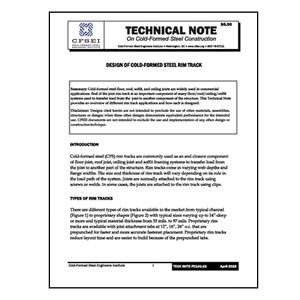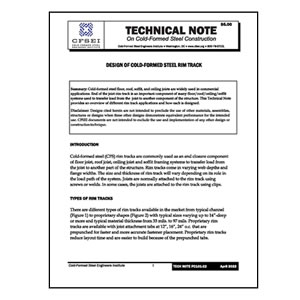Tech Note W104-23: Top Track Load Distribution Members
$5.00
This Tech Note Updates and Replaces Tech Note W104-10
Summary: When in-line framing is not adopted as the structural framing scheme, the top track must be relied upon to provide load distribution. This Technical Note explores design issues and provides design guidance for some of the typical top track load distribution members and systems.
Disclaimer: Designs cited herein are not intended to preclude the use of other materials, assemblies, structures or designs when these other designs demonstrate equivalent performance for the intended use. CFSEI documents are not intended to exclude the use and implementation of any other design or construction technique.
Related Products

Tech Note G200-21: Chase the Loads: Load Path Considerations for Cold-Formed Steel Light-Frame Construction
This Technical Note updates and replaces CFSEI Technical Note G200-15
Summary: Engineering students are admonished to “chase the loads” in their structural analysis and design courses. A “load path” is the direction in which each consecutive load will pass through framing members and the connected members of a framing assembly. The load path sequence begins at the point of load application, both vertical (gravity, wind uplift or seismic vertical) and lateral, on the structure and works all the way down to the footing or foundation system, ultimately transferring the load of the structure to the foundation. This Tech Note provides insight into the load path considerations for cold-formed steel framing.
Disclaimer: Designs cited herein are not intended to preclude the use of other materials, assemblies, structures or designs when these other designs demonstrate equivalent performance for the intended use. CFSEI documents are not intended to exclude the use and implementation of any other design or construction technique.

Tech Note G102-09: Designing Cold-Formed Steel using the Direct Strength Method
Summary: The Direct Strength Method is an entirely new design method for cold-formed steel. The Direct Strength Method requires no effective width calculations, eliminates tedious iterations to determine section properties, properly includes interaction effects between elements of the cross-section such as the flange and the web, and opens up the potential to create new sections as it is applicable to nearly any shape that can be formed from cold-formed steel, as opposed to just C, Z and hat shapes. The Direct Strength Method was first adopted in 2004 as Appendix 1 to the North American Specification for the Design of Cold-Formed Steel Structural Members, and the most recent version can be found in the recently published AISI-S100-07. This CFSEI Technical Note introduces the Direct Strength Method and details some of the features of a recently published AISI Design Guide for this Method. The intent of this Tech Note and the Guide is to provide engineers with practical guidance in the application of this new design method.
Note: This document was originally published as G100-09, Corrected to G102-09 in April 2011
Disclaimer: Designs cited herein are not intended to preclude the use of other materials, assemblies, structures or designs when these other designs demonstrate equivalent performance for the intended use. CFSEI documents are not intended to exclude the use and implementation of any other design or construction technique.

Tech Note F602-20: Screw Connections with Other Materials or Gaps Between the Plies
Summary: Screws are the most common connection type for connecting cold-formed steel members to one another. It is also common for gaps to be provided between members in the form of other materials such as gypsum or insulation, but unfortunately, the current standards do not provide clear direction for the design of screwed connections with gaps in the material. This Tech Note will summarize available test data and propose design guidance based on the available test data.
Disclaimer: Designs cited herein are not intended to preclude the use of other materials, assemblies, structures or designs when these other designs demonstrate equivalent performance for the intended use. CFSEI documents are not intended to exclude the use and implementation of any other design or construction technique.

Tech Note B005-20: Introduction to Cold-Formed Steel Framing Design Aids
Summary: Both steel industry and manufacturers’ associations provide design aids that assist engineers with the proper application of the cold-formed steel design challenges. Design examples and design aids are essential to educate an engineer in the proper use and design of cold-formed steel members, connections and assemblies. This Tech Note provides an overview of some of the available cold-formed steel framing design aids.
Disclaimer: Designs cited herein are not intended to preclude the use of other materials, assemblies, structures or designs when these other designs demonstrate equivalent performance for the intended use. CFSEI documents are not intended to exclude the use and implementation of any other design or construction technique.

Tech Note S200-20: Design of Cold-Formed Steel Systems for Raised Platforms, Stages and Theater Seating
Summary: It is common for cold-formed steel (CFS) to be used in the construction of raised platforms, stages, and theater seating. It is the intent of the Technical Note to provide an overview of considerations to address when designing such framing, along with some design examples.
Disclaimer: Designs cited herein are not intended to preclude the use of other materials, assemblies, structures or designs when these other designs demonstrate equivalent performance for the intended use. CFSEI documents are not intended to exclude the use and implementation of any other design or construction technique.

Tech Note G101-08: Design Aids and Examples for Distortional Buckling
Summary: The objective of this Tech Note is to provide design examples and design aids specific to cold-formed steel framing systems that address the new distortional buckling limit states added to AISI-S100 in the 2007 edition. In addition, a method is provided for including rotational restraint, provided by sheathing to members, in the design calculations for distortional buckling. This method has been proposed for the next edition of AISI-S210 (floors and roofs) and AISI-S211 (walls studs) standards and partially mitigates the reduced capacity in the distortional buckling limit state.
Note: This document was originally published as G100-08, corrected to G101-08 in April 2011.
Disclaimer: Designs cited herein are not intended to preclude the use of other materials, assemblies, structures or designs when these other designs demonstrate equivalent performance for the intended use. CFSEI documents are not intended to exclude the use and implementation of any other design or construction technique.

Tech Note G103-11a: Tabulated Local And Distortional Elastic Buckling Solutions For Standard Shapes
Summary: This note provides elastic buckling moments and forces for local and distortional buckling of typical standard sections such as those in the AISI S201 Standard for Cold-Formed Steel Framing—Product Data and the Steel Stud Manufacturers Association (SSMA) Product Technical Information Catalog. These tabulated values allow designers to quickly examine and evaluate the use of the direct strength method (DSM) for design. Note that basic information on DSM is discussed in CFSEI Technical Note G102.
Disclaimer: Designs cited herein are not intended to preclude the use of other materials, assemblies, structures or designs when these other designs demonstrate equivalent performance for the intended use. CFSEI documents are not intended to exclude the use and implementation of any other design or construction technique.

Tech Note 551e: Design Guide: Permanent Bracing of Cold-Formed Steel Trusses
Summary: Prefabricated and site fabricated cold-formed steel trusses have proven to be efficient and structurally-sound roof structures. While roof trusses are the major component of the structural roof system, permanent bracing is also required to complete the system and ensure that it performs as designed. In this Tech Note, the basic requirements and design parameters for permanent bracing of cold-formed steel roof systems will be reviewed.
Disclaimer: Designs cited herein are not intended to preclude the use of other materials, assemblies, structures or designs when these other designs demonstrate equivalent performance for the intended use. CFSEI documents are not intended to exclude the use and implementation of any other design or construction technique.

